Finance and Funding in Travel and Tourism Sector: AHTC Analysis Report
VerifiedAdded on 2020/01/21
|15
|3853
|123
Report
AI Summary
This report provides a comprehensive financial analysis of AHTC within the travel and tourism sector. It begins with an introduction to management accounting, followed by a detailed examination of cost-volume-profit analysis and its significance. The report explores various pricing methods applicable to AHTC, factors influencing profitability, and presents a budget analysis with variance analysis. Investment appraisal techniques, including payback period, accounting rate of return, internal rate of return, and net present value, are applied to evaluate potential projects. Furthermore, the report includes a thorough ratio analysis and discusses sources and distribution of funds within travel and tourism projects, culminating in a conclusion summarizing the key findings and recommendations.

FINANCE AND FUNDING IN
TRAVEL AND TORUSIM
SECTOR
TRAVEL AND TORUSIM
SECTOR
Paraphrase This Document
Need a fresh take? Get an instant paraphrase of this document with our AI Paraphraser

TABLE OF CONTENT
INTRODUCTION.......................................................................................................................................3
TASK 1.......................................................................................................................................................3
(A) Cost volume profit and its importance to the business firms.............................................................3
(B) Analysis of pricing methods that can be used by AHTC...................................................................4
© Factors that will influence profit of AHTC..........................................................................................5
TASK 2.......................................................................................................................................................6
2.1 Management accounting information................................................................................................6
2.2 Investment appraisal for AHTC.........................................................................................................9
TASK 3.....................................................................................................................................................11
3.1 Ratio analysis...................................................................................................................................11
TASK 4.....................................................................................................................................................13
4.1 Sources and distribution of funds for travel and tourism projects....................................................13
CONCLUSON..........................................................................................................................................13
REFERENCES..........................................................................................................................................14
Table 1 Budget for AHTC...........................................................................................................................7
Table 2 Actual performance on budget by AHTC.......................................................................................8
Table 3 Variance analysis of performance...................................................................................................8
Table 4 Calculation of payback period........................................................................................................9
Table 5 Calculation of ARR......................................................................................................................10
Table 6 Calculation of IRR........................................................................................................................10
Table 7 Calculation of NPV......................................................................................................................11
Table 8 Ratio analysis of Thomas cook.....................................................................................................11
INTRODUCTION.......................................................................................................................................3
TASK 1.......................................................................................................................................................3
(A) Cost volume profit and its importance to the business firms.............................................................3
(B) Analysis of pricing methods that can be used by AHTC...................................................................4
© Factors that will influence profit of AHTC..........................................................................................5
TASK 2.......................................................................................................................................................6
2.1 Management accounting information................................................................................................6
2.2 Investment appraisal for AHTC.........................................................................................................9
TASK 3.....................................................................................................................................................11
3.1 Ratio analysis...................................................................................................................................11
TASK 4.....................................................................................................................................................13
4.1 Sources and distribution of funds for travel and tourism projects....................................................13
CONCLUSON..........................................................................................................................................13
REFERENCES..........................................................................................................................................14
Table 1 Budget for AHTC...........................................................................................................................7
Table 2 Actual performance on budget by AHTC.......................................................................................8
Table 3 Variance analysis of performance...................................................................................................8
Table 4 Calculation of payback period........................................................................................................9
Table 5 Calculation of ARR......................................................................................................................10
Table 6 Calculation of IRR........................................................................................................................10
Table 7 Calculation of NPV......................................................................................................................11
Table 8 Ratio analysis of Thomas cook.....................................................................................................11
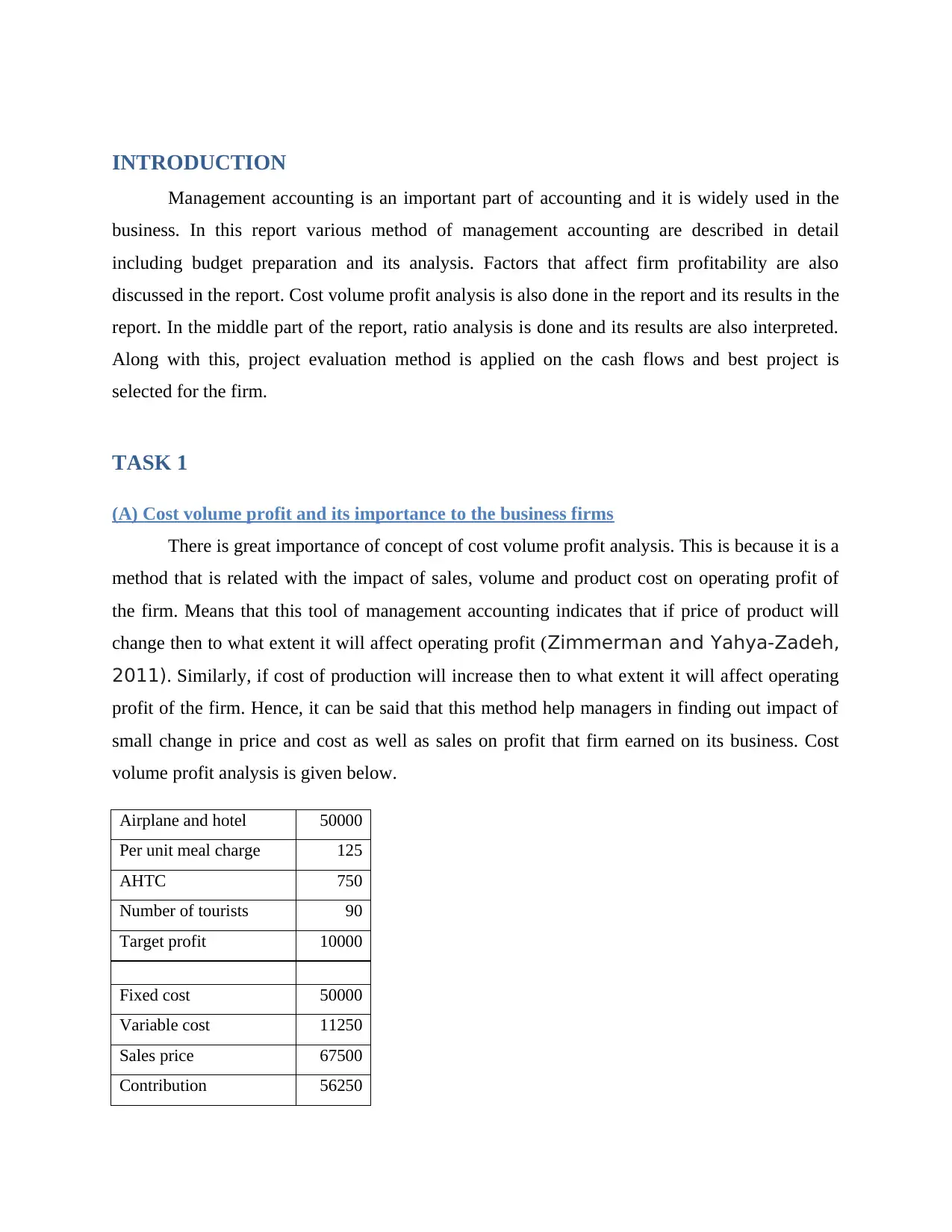
INTRODUCTION
Management accounting is an important part of accounting and it is widely used in the
business. In this report various method of management accounting are described in detail
including budget preparation and its analysis. Factors that affect firm profitability are also
discussed in the report. Cost volume profit analysis is also done in the report and its results in the
report. In the middle part of the report, ratio analysis is done and its results are also interpreted.
Along with this, project evaluation method is applied on the cash flows and best project is
selected for the firm.
TASK 1
(A) Cost volume profit and its importance to the business firms
There is great importance of concept of cost volume profit analysis. This is because it is a
method that is related with the impact of sales, volume and product cost on operating profit of
the firm. Means that this tool of management accounting indicates that if price of product will
change then to what extent it will affect operating profit (Zimmerman and Yahya-Zadeh,
2011). Similarly, if cost of production will increase then to what extent it will affect operating
profit of the firm. Hence, it can be said that this method help managers in finding out impact of
small change in price and cost as well as sales on profit that firm earned on its business. Cost
volume profit analysis is given below.
Airplane and hotel 50000
Per unit meal charge 125
AHTC 750
Number of tourists 90
Target profit 10000
Fixed cost 50000
Variable cost 11250
Sales price 67500
Contribution 56250
Management accounting is an important part of accounting and it is widely used in the
business. In this report various method of management accounting are described in detail
including budget preparation and its analysis. Factors that affect firm profitability are also
discussed in the report. Cost volume profit analysis is also done in the report and its results in the
report. In the middle part of the report, ratio analysis is done and its results are also interpreted.
Along with this, project evaluation method is applied on the cash flows and best project is
selected for the firm.
TASK 1
(A) Cost volume profit and its importance to the business firms
There is great importance of concept of cost volume profit analysis. This is because it is a
method that is related with the impact of sales, volume and product cost on operating profit of
the firm. Means that this tool of management accounting indicates that if price of product will
change then to what extent it will affect operating profit (Zimmerman and Yahya-Zadeh,
2011). Similarly, if cost of production will increase then to what extent it will affect operating
profit of the firm. Hence, it can be said that this method help managers in finding out impact of
small change in price and cost as well as sales on profit that firm earned on its business. Cost
volume profit analysis is given below.
Airplane and hotel 50000
Per unit meal charge 125
AHTC 750
Number of tourists 90
Target profit 10000
Fixed cost 50000
Variable cost 11250
Sales price 67500
Contribution 56250
⊘ This is a preview!⊘
Do you want full access?
Subscribe today to unlock all pages.

Trusted by 1+ million students worldwide
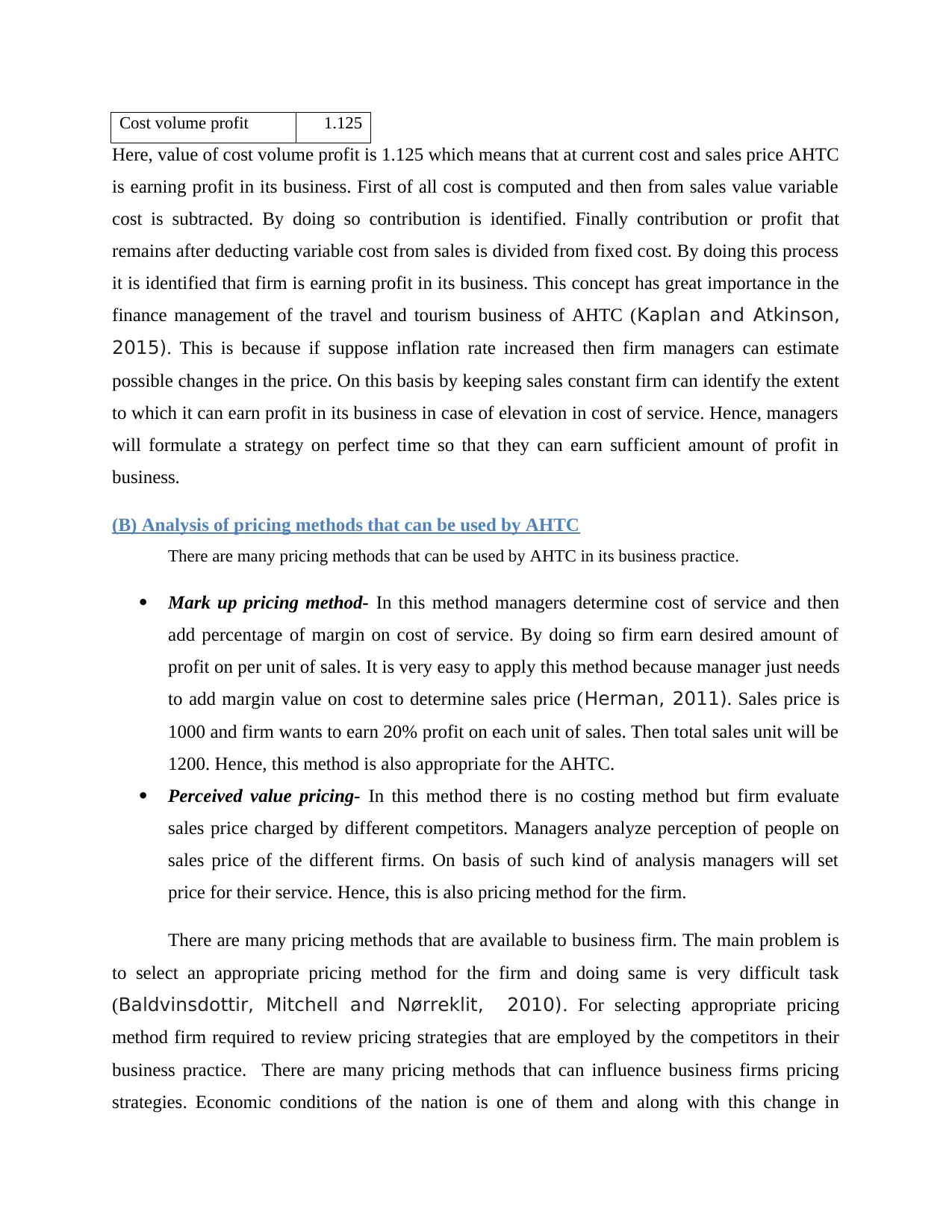
Cost volume profit 1.125
Here, value of cost volume profit is 1.125 which means that at current cost and sales price AHTC
is earning profit in its business. First of all cost is computed and then from sales value variable
cost is subtracted. By doing so contribution is identified. Finally contribution or profit that
remains after deducting variable cost from sales is divided from fixed cost. By doing this process
it is identified that firm is earning profit in its business. This concept has great importance in the
finance management of the travel and tourism business of AHTC (Kaplan and Atkinson,
2015). This is because if suppose inflation rate increased then firm managers can estimate
possible changes in the price. On this basis by keeping sales constant firm can identify the extent
to which it can earn profit in its business in case of elevation in cost of service. Hence, managers
will formulate a strategy on perfect time so that they can earn sufficient amount of profit in
business.
(B) Analysis of pricing methods that can be used by AHTC
There are many pricing methods that can be used by AHTC in its business practice.
Mark up pricing method- In this method managers determine cost of service and then
add percentage of margin on cost of service. By doing so firm earn desired amount of
profit on per unit of sales. It is very easy to apply this method because manager just needs
to add margin value on cost to determine sales price (Herman, 2011). Sales price is
1000 and firm wants to earn 20% profit on each unit of sales. Then total sales unit will be
1200. Hence, this method is also appropriate for the AHTC.
Perceived value pricing- In this method there is no costing method but firm evaluate
sales price charged by different competitors. Managers analyze perception of people on
sales price of the different firms. On basis of such kind of analysis managers will set
price for their service. Hence, this is also pricing method for the firm.
There are many pricing methods that are available to business firm. The main problem is
to select an appropriate pricing method for the firm and doing same is very difficult task
(Baldvinsdottir, Mitchell and Nørreklit, 2010). For selecting appropriate pricing
method firm required to review pricing strategies that are employed by the competitors in their
business practice. There are many pricing methods that can influence business firms pricing
strategies. Economic conditions of the nation is one of them and along with this change in
Here, value of cost volume profit is 1.125 which means that at current cost and sales price AHTC
is earning profit in its business. First of all cost is computed and then from sales value variable
cost is subtracted. By doing so contribution is identified. Finally contribution or profit that
remains after deducting variable cost from sales is divided from fixed cost. By doing this process
it is identified that firm is earning profit in its business. This concept has great importance in the
finance management of the travel and tourism business of AHTC (Kaplan and Atkinson,
2015). This is because if suppose inflation rate increased then firm managers can estimate
possible changes in the price. On this basis by keeping sales constant firm can identify the extent
to which it can earn profit in its business in case of elevation in cost of service. Hence, managers
will formulate a strategy on perfect time so that they can earn sufficient amount of profit in
business.
(B) Analysis of pricing methods that can be used by AHTC
There are many pricing methods that can be used by AHTC in its business practice.
Mark up pricing method- In this method managers determine cost of service and then
add percentage of margin on cost of service. By doing so firm earn desired amount of
profit on per unit of sales. It is very easy to apply this method because manager just needs
to add margin value on cost to determine sales price (Herman, 2011). Sales price is
1000 and firm wants to earn 20% profit on each unit of sales. Then total sales unit will be
1200. Hence, this method is also appropriate for the AHTC.
Perceived value pricing- In this method there is no costing method but firm evaluate
sales price charged by different competitors. Managers analyze perception of people on
sales price of the different firms. On basis of such kind of analysis managers will set
price for their service. Hence, this is also pricing method for the firm.
There are many pricing methods that are available to business firm. The main problem is
to select an appropriate pricing method for the firm and doing same is very difficult task
(Baldvinsdottir, Mitchell and Nørreklit, 2010). For selecting appropriate pricing
method firm required to review pricing strategies that are employed by the competitors in their
business practice. There are many pricing methods that can influence business firms pricing
strategies. Economic conditions of the nation is one of them and along with this change in
Paraphrase This Document
Need a fresh take? Get an instant paraphrase of this document with our AI Paraphraser
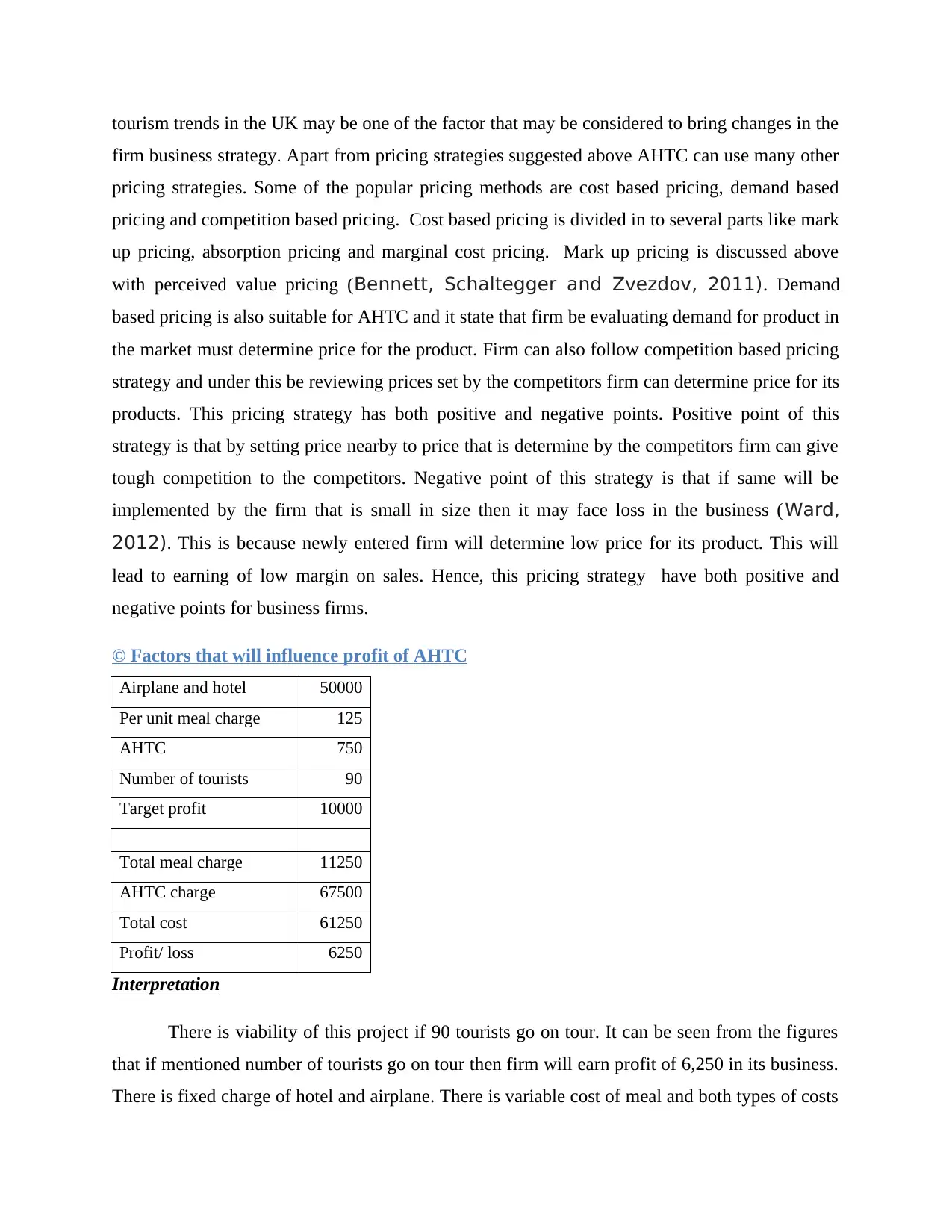
tourism trends in the UK may be one of the factor that may be considered to bring changes in the
firm business strategy. Apart from pricing strategies suggested above AHTC can use many other
pricing strategies. Some of the popular pricing methods are cost based pricing, demand based
pricing and competition based pricing. Cost based pricing is divided in to several parts like mark
up pricing, absorption pricing and marginal cost pricing. Mark up pricing is discussed above
with perceived value pricing (Bennett, Schaltegger and Zvezdov, 2011). Demand
based pricing is also suitable for AHTC and it state that firm be evaluating demand for product in
the market must determine price for the product. Firm can also follow competition based pricing
strategy and under this be reviewing prices set by the competitors firm can determine price for its
products. This pricing strategy has both positive and negative points. Positive point of this
strategy is that by setting price nearby to price that is determine by the competitors firm can give
tough competition to the competitors. Negative point of this strategy is that if same will be
implemented by the firm that is small in size then it may face loss in the business (Ward,
2012). This is because newly entered firm will determine low price for its product. This will
lead to earning of low margin on sales. Hence, this pricing strategy have both positive and
negative points for business firms.
© Factors that will influence profit of AHTC
Airplane and hotel 50000
Per unit meal charge 125
AHTC 750
Number of tourists 90
Target profit 10000
Total meal charge 11250
AHTC charge 67500
Total cost 61250
Profit/ loss 6250
Interpretation
There is viability of this project if 90 tourists go on tour. It can be seen from the figures
that if mentioned number of tourists go on tour then firm will earn profit of 6,250 in its business.
There is fixed charge of hotel and airplane. There is variable cost of meal and both types of costs
firm business strategy. Apart from pricing strategies suggested above AHTC can use many other
pricing strategies. Some of the popular pricing methods are cost based pricing, demand based
pricing and competition based pricing. Cost based pricing is divided in to several parts like mark
up pricing, absorption pricing and marginal cost pricing. Mark up pricing is discussed above
with perceived value pricing (Bennett, Schaltegger and Zvezdov, 2011). Demand
based pricing is also suitable for AHTC and it state that firm be evaluating demand for product in
the market must determine price for the product. Firm can also follow competition based pricing
strategy and under this be reviewing prices set by the competitors firm can determine price for its
products. This pricing strategy has both positive and negative points. Positive point of this
strategy is that by setting price nearby to price that is determine by the competitors firm can give
tough competition to the competitors. Negative point of this strategy is that if same will be
implemented by the firm that is small in size then it may face loss in the business (Ward,
2012). This is because newly entered firm will determine low price for its product. This will
lead to earning of low margin on sales. Hence, this pricing strategy have both positive and
negative points for business firms.
© Factors that will influence profit of AHTC
Airplane and hotel 50000
Per unit meal charge 125
AHTC 750
Number of tourists 90
Target profit 10000
Total meal charge 11250
AHTC charge 67500
Total cost 61250
Profit/ loss 6250
Interpretation
There is viability of this project if 90 tourists go on tour. It can be seen from the figures
that if mentioned number of tourists go on tour then firm will earn profit of 6,250 in its business.
There is fixed charge of hotel and airplane. There is variable cost of meal and both types of costs
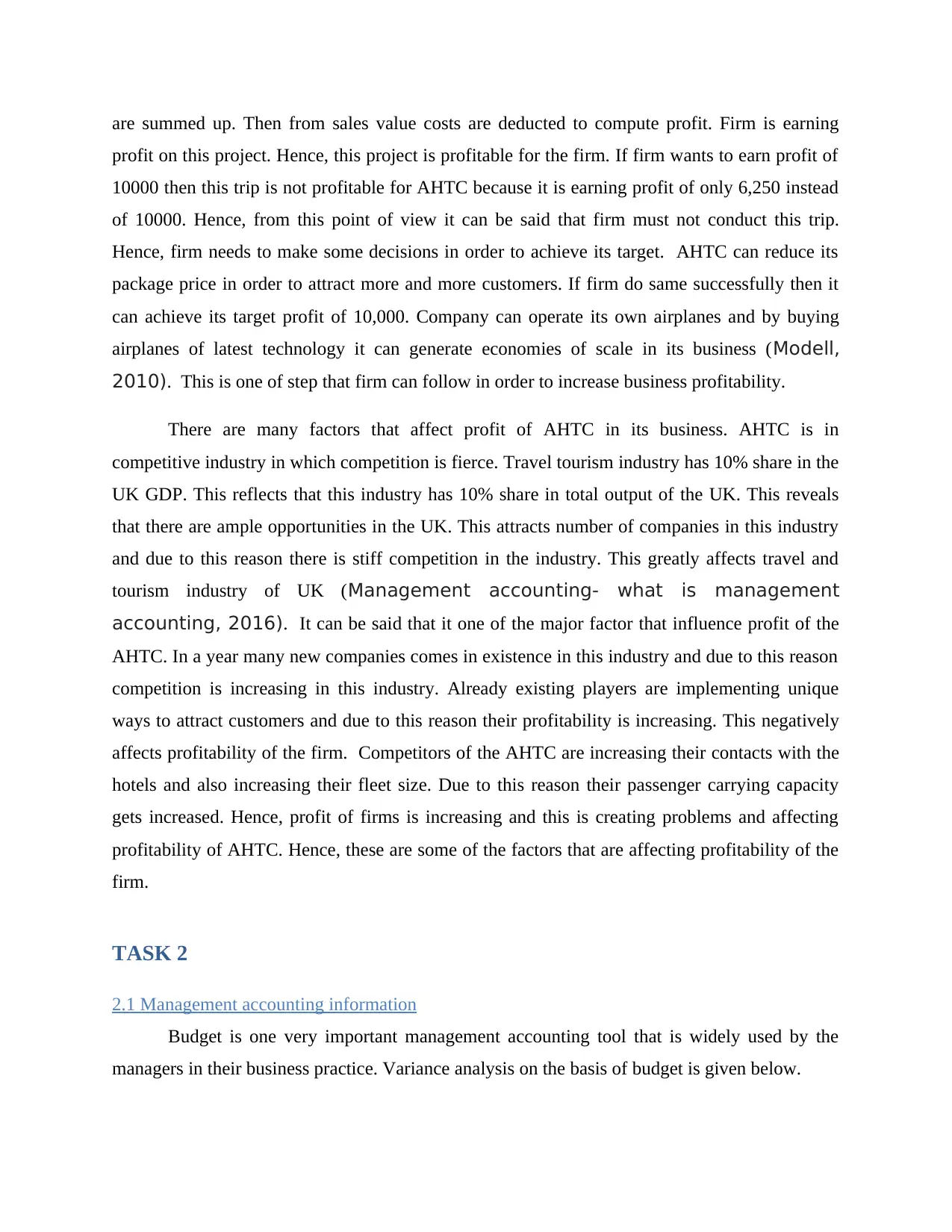
are summed up. Then from sales value costs are deducted to compute profit. Firm is earning
profit on this project. Hence, this project is profitable for the firm. If firm wants to earn profit of
10000 then this trip is not profitable for AHTC because it is earning profit of only 6,250 instead
of 10000. Hence, from this point of view it can be said that firm must not conduct this trip.
Hence, firm needs to make some decisions in order to achieve its target. AHTC can reduce its
package price in order to attract more and more customers. If firm do same successfully then it
can achieve its target profit of 10,000. Company can operate its own airplanes and by buying
airplanes of latest technology it can generate economies of scale in its business (Modell,
2010). This is one of step that firm can follow in order to increase business profitability.
There are many factors that affect profit of AHTC in its business. AHTC is in
competitive industry in which competition is fierce. Travel tourism industry has 10% share in the
UK GDP. This reflects that this industry has 10% share in total output of the UK. This reveals
that there are ample opportunities in the UK. This attracts number of companies in this industry
and due to this reason there is stiff competition in the industry. This greatly affects travel and
tourism industry of UK (Management accounting- what is management
accounting, 2016). It can be said that it one of the major factor that influence profit of the
AHTC. In a year many new companies comes in existence in this industry and due to this reason
competition is increasing in this industry. Already existing players are implementing unique
ways to attract customers and due to this reason their profitability is increasing. This negatively
affects profitability of the firm. Competitors of the AHTC are increasing their contacts with the
hotels and also increasing their fleet size. Due to this reason their passenger carrying capacity
gets increased. Hence, profit of firms is increasing and this is creating problems and affecting
profitability of AHTC. Hence, these are some of the factors that are affecting profitability of the
firm.
TASK 2
2.1 Management accounting information
Budget is one very important management accounting tool that is widely used by the
managers in their business practice. Variance analysis on the basis of budget is given below.
profit on this project. Hence, this project is profitable for the firm. If firm wants to earn profit of
10000 then this trip is not profitable for AHTC because it is earning profit of only 6,250 instead
of 10000. Hence, from this point of view it can be said that firm must not conduct this trip.
Hence, firm needs to make some decisions in order to achieve its target. AHTC can reduce its
package price in order to attract more and more customers. If firm do same successfully then it
can achieve its target profit of 10,000. Company can operate its own airplanes and by buying
airplanes of latest technology it can generate economies of scale in its business (Modell,
2010). This is one of step that firm can follow in order to increase business profitability.
There are many factors that affect profit of AHTC in its business. AHTC is in
competitive industry in which competition is fierce. Travel tourism industry has 10% share in the
UK GDP. This reflects that this industry has 10% share in total output of the UK. This reveals
that there are ample opportunities in the UK. This attracts number of companies in this industry
and due to this reason there is stiff competition in the industry. This greatly affects travel and
tourism industry of UK (Management accounting- what is management
accounting, 2016). It can be said that it one of the major factor that influence profit of the
AHTC. In a year many new companies comes in existence in this industry and due to this reason
competition is increasing in this industry. Already existing players are implementing unique
ways to attract customers and due to this reason their profitability is increasing. This negatively
affects profitability of the firm. Competitors of the AHTC are increasing their contacts with the
hotels and also increasing their fleet size. Due to this reason their passenger carrying capacity
gets increased. Hence, profit of firms is increasing and this is creating problems and affecting
profitability of AHTC. Hence, these are some of the factors that are affecting profitability of the
firm.
TASK 2
2.1 Management accounting information
Budget is one very important management accounting tool that is widely used by the
managers in their business practice. Variance analysis on the basis of budget is given below.
⊘ This is a preview!⊘
Do you want full access?
Subscribe today to unlock all pages.

Trusted by 1+ million students worldwide
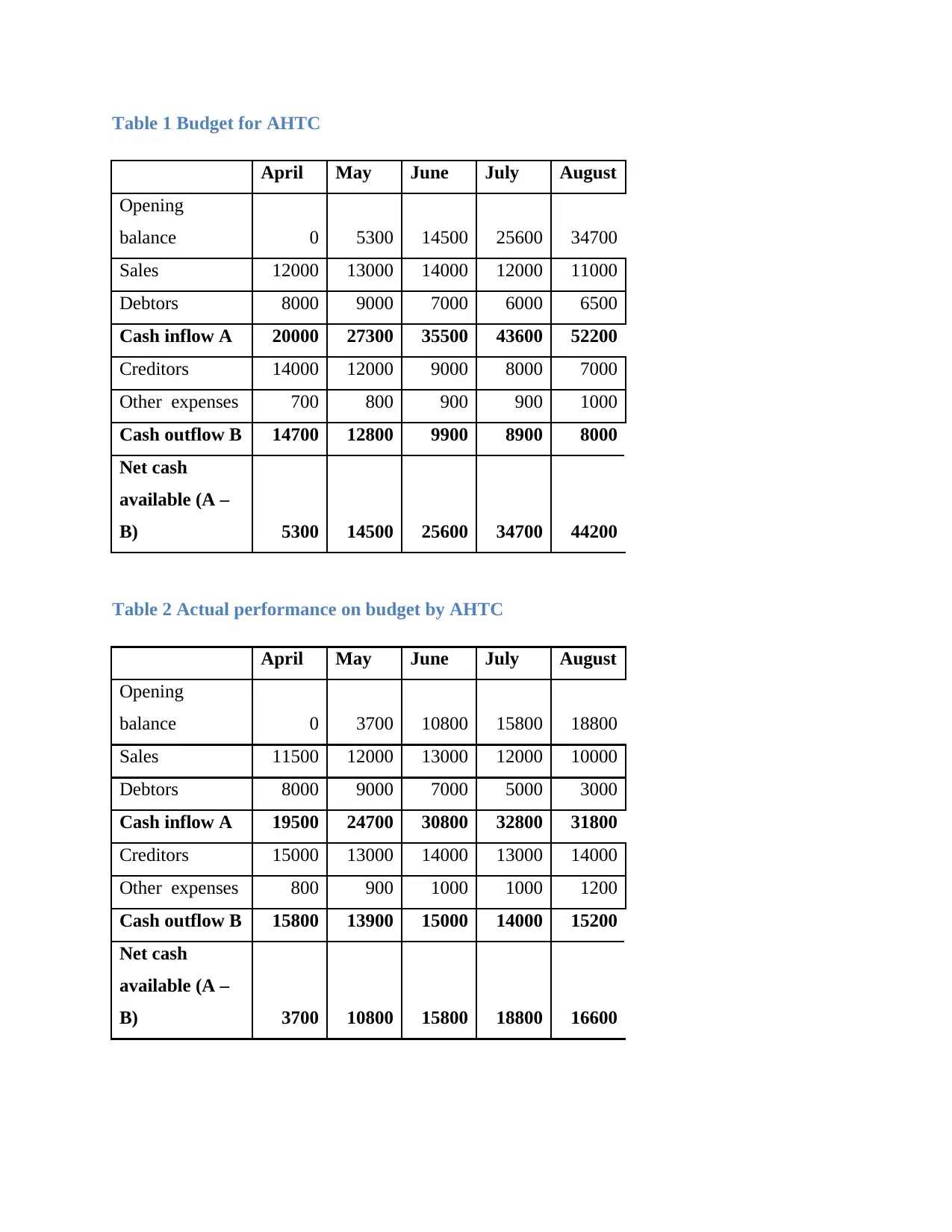
Table 1 Budget for AHTC
April May June July August
Opening
balance 0 5300 14500 25600 34700
Sales 12000 13000 14000 12000 11000
Debtors 8000 9000 7000 6000 6500
Cash inflow A 20000 27300 35500 43600 52200
Creditors 14000 12000 9000 8000 7000
Other expenses 700 800 900 900 1000
Cash outflow B 14700 12800 9900 8900 8000
Net cash
available (A –
B) 5300 14500 25600 34700 44200
Table 2 Actual performance on budget by AHTC
April May June July August
Opening
balance 0 3700 10800 15800 18800
Sales 11500 12000 13000 12000 10000
Debtors 8000 9000 7000 5000 3000
Cash inflow A 19500 24700 30800 32800 31800
Creditors 15000 13000 14000 13000 14000
Other expenses 800 900 1000 1000 1200
Cash outflow B 15800 13900 15000 14000 15200
Net cash
available (A –
B) 3700 10800 15800 18800 16600
April May June July August
Opening
balance 0 5300 14500 25600 34700
Sales 12000 13000 14000 12000 11000
Debtors 8000 9000 7000 6000 6500
Cash inflow A 20000 27300 35500 43600 52200
Creditors 14000 12000 9000 8000 7000
Other expenses 700 800 900 900 1000
Cash outflow B 14700 12800 9900 8900 8000
Net cash
available (A –
B) 5300 14500 25600 34700 44200
Table 2 Actual performance on budget by AHTC
April May June July August
Opening
balance 0 3700 10800 15800 18800
Sales 11500 12000 13000 12000 10000
Debtors 8000 9000 7000 5000 3000
Cash inflow A 19500 24700 30800 32800 31800
Creditors 15000 13000 14000 13000 14000
Other expenses 800 900 1000 1000 1200
Cash outflow B 15800 13900 15000 14000 15200
Net cash
available (A –
B) 3700 10800 15800 18800 16600
Paraphrase This Document
Need a fresh take? Get an instant paraphrase of this document with our AI Paraphraser
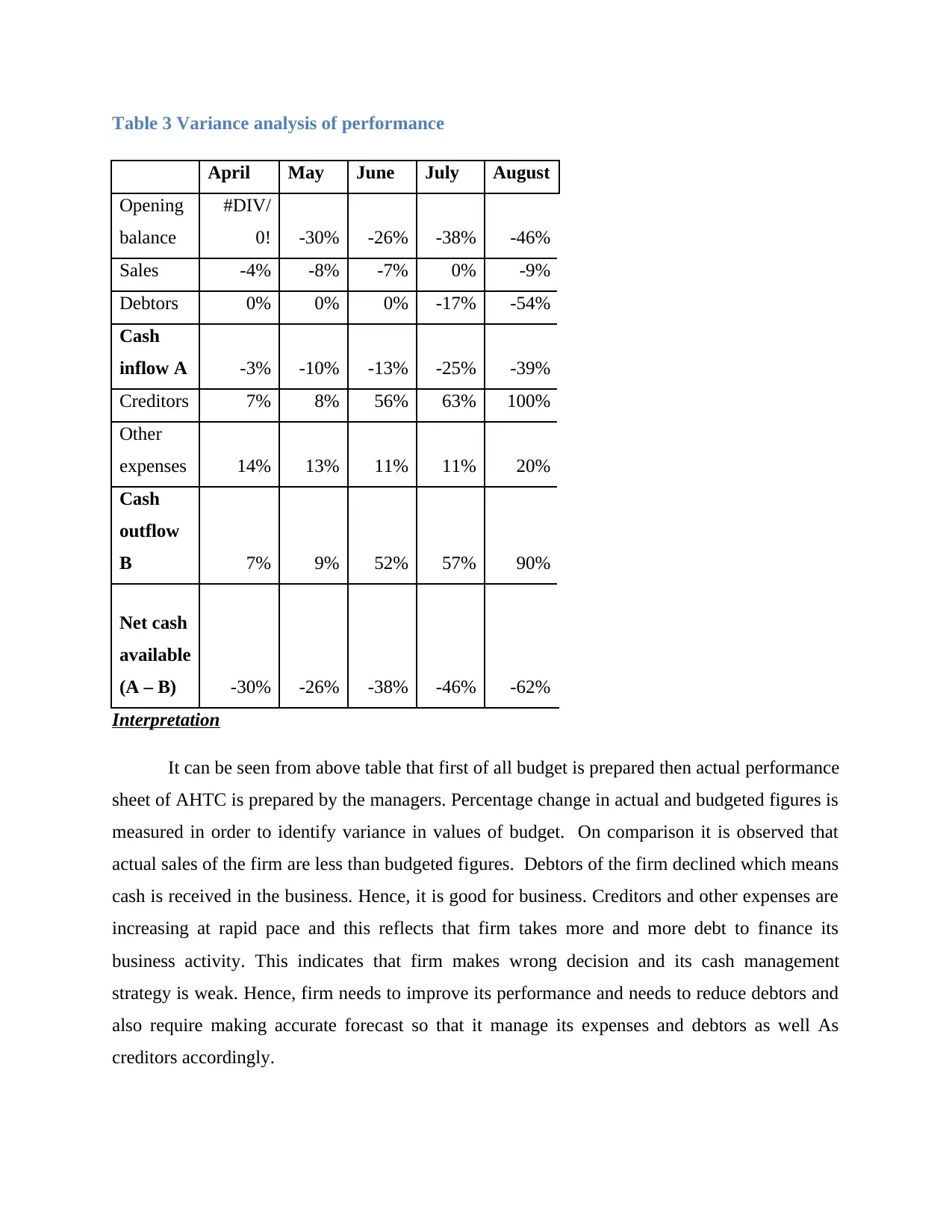
Table 3 Variance analysis of performance
April May June July August
Opening
balance
#DIV/
0! -30% -26% -38% -46%
Sales -4% -8% -7% 0% -9%
Debtors 0% 0% 0% -17% -54%
Cash
inflow A -3% -10% -13% -25% -39%
Creditors 7% 8% 56% 63% 100%
Other
expenses 14% 13% 11% 11% 20%
Cash
outflow
B 7% 9% 52% 57% 90%
Net cash
available
(A – B) -30% -26% -38% -46% -62%
Interpretation
It can be seen from above table that first of all budget is prepared then actual performance
sheet of AHTC is prepared by the managers. Percentage change in actual and budgeted figures is
measured in order to identify variance in values of budget. On comparison it is observed that
actual sales of the firm are less than budgeted figures. Debtors of the firm declined which means
cash is received in the business. Hence, it is good for business. Creditors and other expenses are
increasing at rapid pace and this reflects that firm takes more and more debt to finance its
business activity. This indicates that firm makes wrong decision and its cash management
strategy is weak. Hence, firm needs to improve its performance and needs to reduce debtors and
also require making accurate forecast so that it manage its expenses and debtors as well As
creditors accordingly.
April May June July August
Opening
balance
#DIV/
0! -30% -26% -38% -46%
Sales -4% -8% -7% 0% -9%
Debtors 0% 0% 0% -17% -54%
Cash
inflow A -3% -10% -13% -25% -39%
Creditors 7% 8% 56% 63% 100%
Other
expenses 14% 13% 11% 11% 20%
Cash
outflow
B 7% 9% 52% 57% 90%
Net cash
available
(A – B) -30% -26% -38% -46% -62%
Interpretation
It can be seen from above table that first of all budget is prepared then actual performance
sheet of AHTC is prepared by the managers. Percentage change in actual and budgeted figures is
measured in order to identify variance in values of budget. On comparison it is observed that
actual sales of the firm are less than budgeted figures. Debtors of the firm declined which means
cash is received in the business. Hence, it is good for business. Creditors and other expenses are
increasing at rapid pace and this reflects that firm takes more and more debt to finance its
business activity. This indicates that firm makes wrong decision and its cash management
strategy is weak. Hence, firm needs to improve its performance and needs to reduce debtors and
also require making accurate forecast so that it manage its expenses and debtors as well As
creditors accordingly.
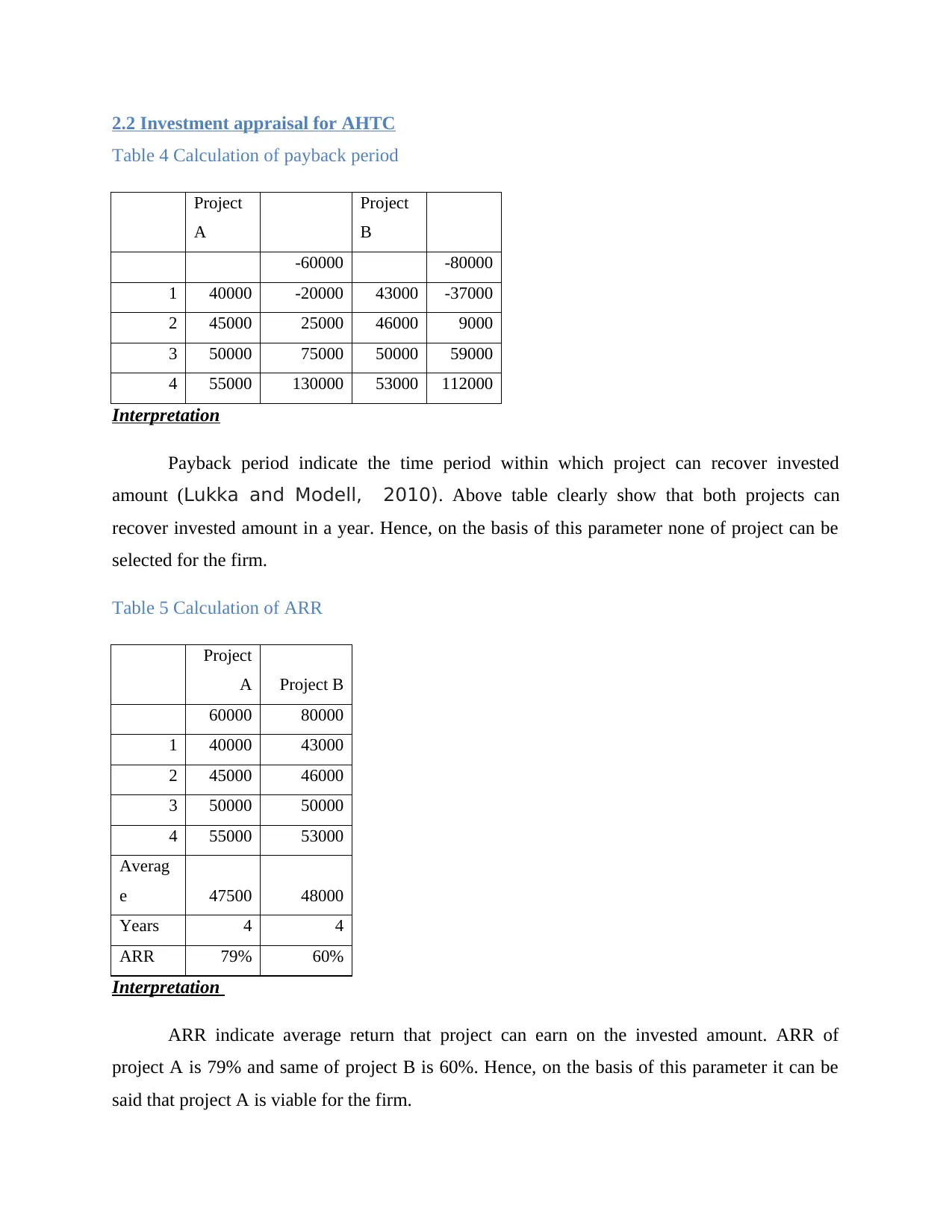
2.2 Investment appraisal for AHTC
Table 4 Calculation of payback period
Project
A
Project
B
-60000 -80000
1 40000 -20000 43000 -37000
2 45000 25000 46000 9000
3 50000 75000 50000 59000
4 55000 130000 53000 112000
Interpretation
Payback period indicate the time period within which project can recover invested
amount (Lukka and Modell, 2010). Above table clearly show that both projects can
recover invested amount in a year. Hence, on the basis of this parameter none of project can be
selected for the firm.
Table 5 Calculation of ARR
Project
A Project B
60000 80000
1 40000 43000
2 45000 46000
3 50000 50000
4 55000 53000
Averag
e 47500 48000
Years 4 4
ARR 79% 60%
Interpretation
ARR indicate average return that project can earn on the invested amount. ARR of
project A is 79% and same of project B is 60%. Hence, on the basis of this parameter it can be
said that project A is viable for the firm.
Table 4 Calculation of payback period
Project
A
Project
B
-60000 -80000
1 40000 -20000 43000 -37000
2 45000 25000 46000 9000
3 50000 75000 50000 59000
4 55000 130000 53000 112000
Interpretation
Payback period indicate the time period within which project can recover invested
amount (Lukka and Modell, 2010). Above table clearly show that both projects can
recover invested amount in a year. Hence, on the basis of this parameter none of project can be
selected for the firm.
Table 5 Calculation of ARR
Project
A Project B
60000 80000
1 40000 43000
2 45000 46000
3 50000 50000
4 55000 53000
Averag
e 47500 48000
Years 4 4
ARR 79% 60%
Interpretation
ARR indicate average return that project can earn on the invested amount. ARR of
project A is 79% and same of project B is 60%. Hence, on the basis of this parameter it can be
said that project A is viable for the firm.
⊘ This is a preview!⊘
Do you want full access?
Subscribe today to unlock all pages.

Trusted by 1+ million students worldwide
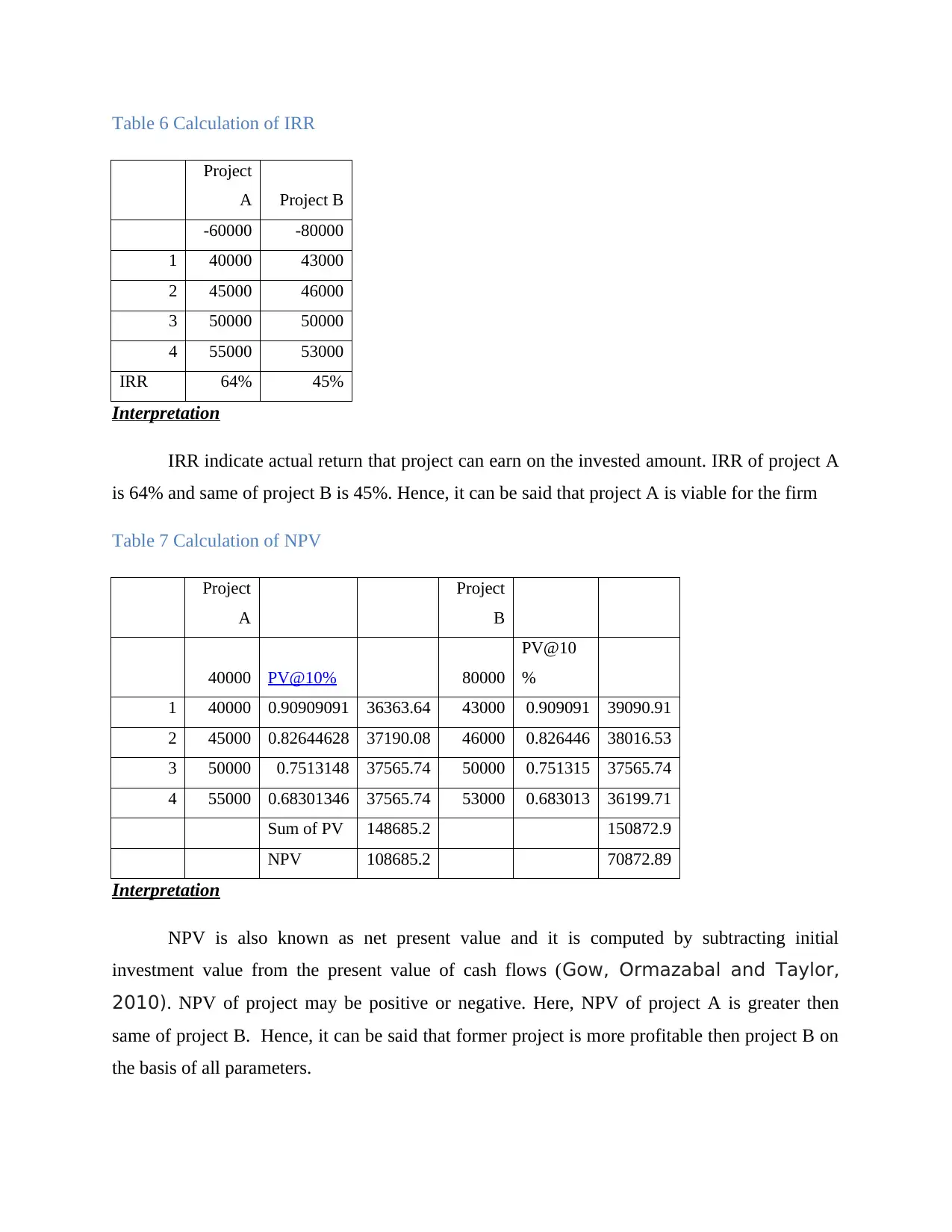
Table 6 Calculation of IRR
Project
A Project B
-60000 -80000
1 40000 43000
2 45000 46000
3 50000 50000
4 55000 53000
IRR 64% 45%
Interpretation
IRR indicate actual return that project can earn on the invested amount. IRR of project A
is 64% and same of project B is 45%. Hence, it can be said that project A is viable for the firm
Table 7 Calculation of NPV
Project
A
Project
B
40000 PV@10% 80000
PV@10
%
1 40000 0.90909091 36363.64 43000 0.909091 39090.91
2 45000 0.82644628 37190.08 46000 0.826446 38016.53
3 50000 0.7513148 37565.74 50000 0.751315 37565.74
4 55000 0.68301346 37565.74 53000 0.683013 36199.71
Sum of PV 148685.2 150872.9
NPV 108685.2 70872.89
Interpretation
NPV is also known as net present value and it is computed by subtracting initial
investment value from the present value of cash flows (Gow, Ormazabal and Taylor,
2010). NPV of project may be positive or negative. Here, NPV of project A is greater then
same of project B. Hence, it can be said that former project is more profitable then project B on
the basis of all parameters.
Project
A Project B
-60000 -80000
1 40000 43000
2 45000 46000
3 50000 50000
4 55000 53000
IRR 64% 45%
Interpretation
IRR indicate actual return that project can earn on the invested amount. IRR of project A
is 64% and same of project B is 45%. Hence, it can be said that project A is viable for the firm
Table 7 Calculation of NPV
Project
A
Project
B
40000 PV@10% 80000
PV@10
%
1 40000 0.90909091 36363.64 43000 0.909091 39090.91
2 45000 0.82644628 37190.08 46000 0.826446 38016.53
3 50000 0.7513148 37565.74 50000 0.751315 37565.74
4 55000 0.68301346 37565.74 53000 0.683013 36199.71
Sum of PV 148685.2 150872.9
NPV 108685.2 70872.89
Interpretation
NPV is also known as net present value and it is computed by subtracting initial
investment value from the present value of cash flows (Gow, Ormazabal and Taylor,
2010). NPV of project may be positive or negative. Here, NPV of project A is greater then
same of project B. Hence, it can be said that former project is more profitable then project B on
the basis of all parameters.
Paraphrase This Document
Need a fresh take? Get an instant paraphrase of this document with our AI Paraphraser
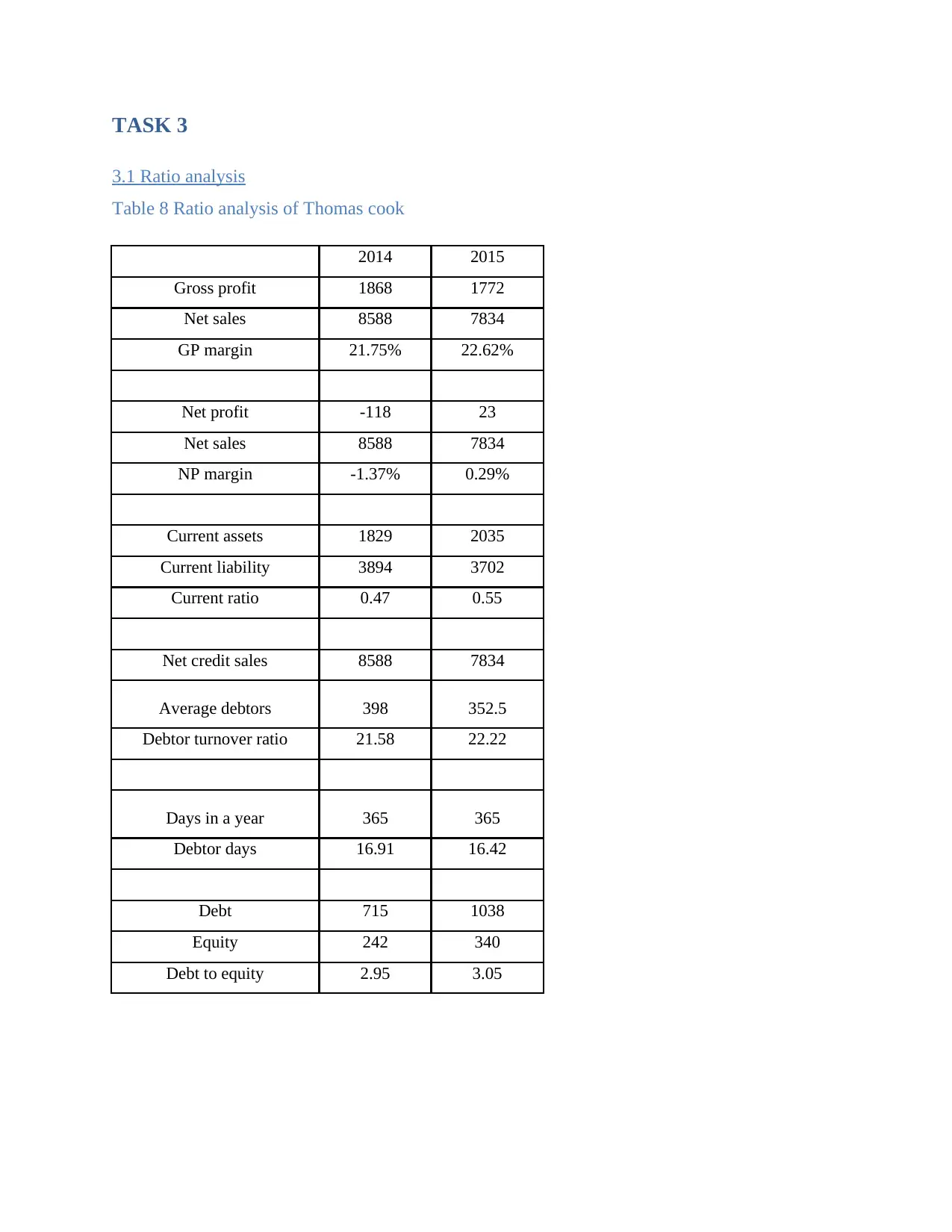
TASK 3
3.1 Ratio analysis
Table 8 Ratio analysis of Thomas cook
2014 2015
Gross profit 1868 1772
Net sales 8588 7834
GP margin 21.75% 22.62%
Net profit -118 23
Net sales 8588 7834
NP margin -1.37% 0.29%
Current assets 1829 2035
Current liability 3894 3702
Current ratio 0.47 0.55
Net credit sales 8588 7834
Average debtors 398 352.5
Debtor turnover ratio 21.58 22.22
Days in a year 365 365
Debtor days 16.91 16.42
Debt 715 1038
Equity 242 340
Debt to equity 2.95 3.05
3.1 Ratio analysis
Table 8 Ratio analysis of Thomas cook
2014 2015
Gross profit 1868 1772
Net sales 8588 7834
GP margin 21.75% 22.62%
Net profit -118 23
Net sales 8588 7834
NP margin -1.37% 0.29%
Current assets 1829 2035
Current liability 3894 3702
Current ratio 0.47 0.55
Net credit sales 8588 7834
Average debtors 398 352.5
Debtor turnover ratio 21.58 22.22
Days in a year 365 365
Debtor days 16.91 16.42
Debt 715 1038
Equity 242 340
Debt to equity 2.95 3.05
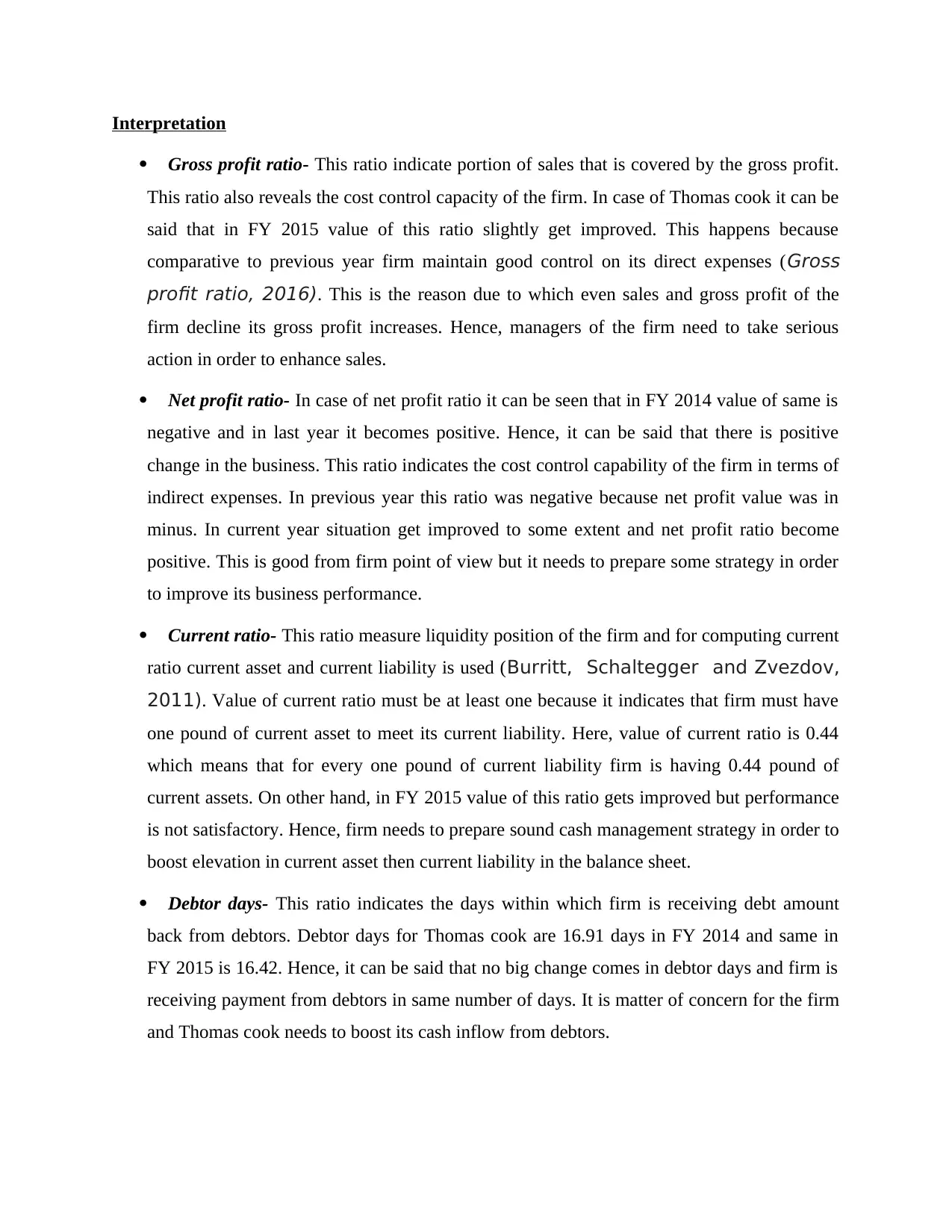
Interpretation
Gross profit ratio- This ratio indicate portion of sales that is covered by the gross profit.
This ratio also reveals the cost control capacity of the firm. In case of Thomas cook it can be
said that in FY 2015 value of this ratio slightly get improved. This happens because
comparative to previous year firm maintain good control on its direct expenses (Gross
profit ratio, 2016). This is the reason due to which even sales and gross profit of the
firm decline its gross profit increases. Hence, managers of the firm need to take serious
action in order to enhance sales.
Net profit ratio- In case of net profit ratio it can be seen that in FY 2014 value of same is
negative and in last year it becomes positive. Hence, it can be said that there is positive
change in the business. This ratio indicates the cost control capability of the firm in terms of
indirect expenses. In previous year this ratio was negative because net profit value was in
minus. In current year situation get improved to some extent and net profit ratio become
positive. This is good from firm point of view but it needs to prepare some strategy in order
to improve its business performance.
Current ratio- This ratio measure liquidity position of the firm and for computing current
ratio current asset and current liability is used (Burritt, Schaltegger and Zvezdov,
2011). Value of current ratio must be at least one because it indicates that firm must have
one pound of current asset to meet its current liability. Here, value of current ratio is 0.44
which means that for every one pound of current liability firm is having 0.44 pound of
current assets. On other hand, in FY 2015 value of this ratio gets improved but performance
is not satisfactory. Hence, firm needs to prepare sound cash management strategy in order to
boost elevation in current asset then current liability in the balance sheet.
Debtor days- This ratio indicates the days within which firm is receiving debt amount
back from debtors. Debtor days for Thomas cook are 16.91 days in FY 2014 and same in
FY 2015 is 16.42. Hence, it can be said that no big change comes in debtor days and firm is
receiving payment from debtors in same number of days. It is matter of concern for the firm
and Thomas cook needs to boost its cash inflow from debtors.
Gross profit ratio- This ratio indicate portion of sales that is covered by the gross profit.
This ratio also reveals the cost control capacity of the firm. In case of Thomas cook it can be
said that in FY 2015 value of this ratio slightly get improved. This happens because
comparative to previous year firm maintain good control on its direct expenses (Gross
profit ratio, 2016). This is the reason due to which even sales and gross profit of the
firm decline its gross profit increases. Hence, managers of the firm need to take serious
action in order to enhance sales.
Net profit ratio- In case of net profit ratio it can be seen that in FY 2014 value of same is
negative and in last year it becomes positive. Hence, it can be said that there is positive
change in the business. This ratio indicates the cost control capability of the firm in terms of
indirect expenses. In previous year this ratio was negative because net profit value was in
minus. In current year situation get improved to some extent and net profit ratio become
positive. This is good from firm point of view but it needs to prepare some strategy in order
to improve its business performance.
Current ratio- This ratio measure liquidity position of the firm and for computing current
ratio current asset and current liability is used (Burritt, Schaltegger and Zvezdov,
2011). Value of current ratio must be at least one because it indicates that firm must have
one pound of current asset to meet its current liability. Here, value of current ratio is 0.44
which means that for every one pound of current liability firm is having 0.44 pound of
current assets. On other hand, in FY 2015 value of this ratio gets improved but performance
is not satisfactory. Hence, firm needs to prepare sound cash management strategy in order to
boost elevation in current asset then current liability in the balance sheet.
Debtor days- This ratio indicates the days within which firm is receiving debt amount
back from debtors. Debtor days for Thomas cook are 16.91 days in FY 2014 and same in
FY 2015 is 16.42. Hence, it can be said that no big change comes in debtor days and firm is
receiving payment from debtors in same number of days. It is matter of concern for the firm
and Thomas cook needs to boost its cash inflow from debtors.
⊘ This is a preview!⊘
Do you want full access?
Subscribe today to unlock all pages.

Trusted by 1+ million students worldwide
1 out of 15
Related Documents
Your All-in-One AI-Powered Toolkit for Academic Success.
+13062052269
info@desklib.com
Available 24*7 on WhatsApp / Email
![[object Object]](/_next/static/media/star-bottom.7253800d.svg)
Unlock your academic potential
Copyright © 2020–2025 A2Z Services. All Rights Reserved. Developed and managed by ZUCOL.





